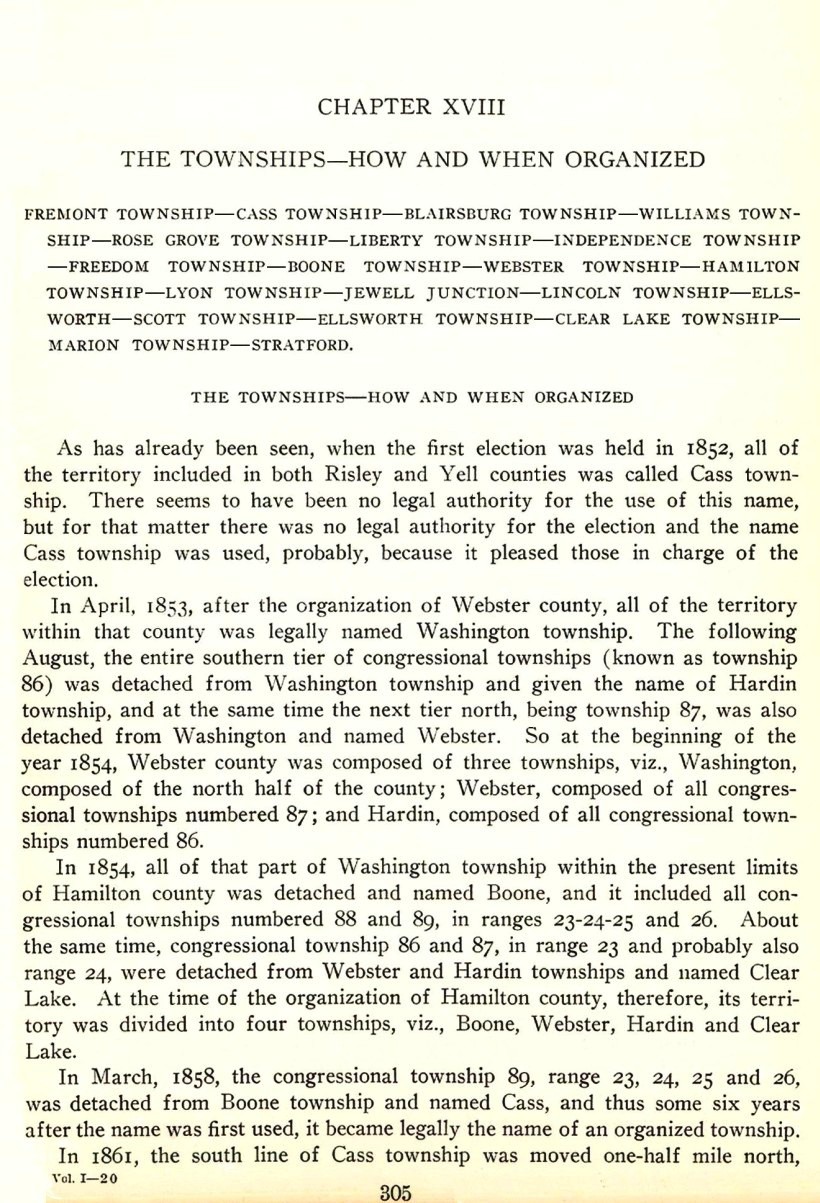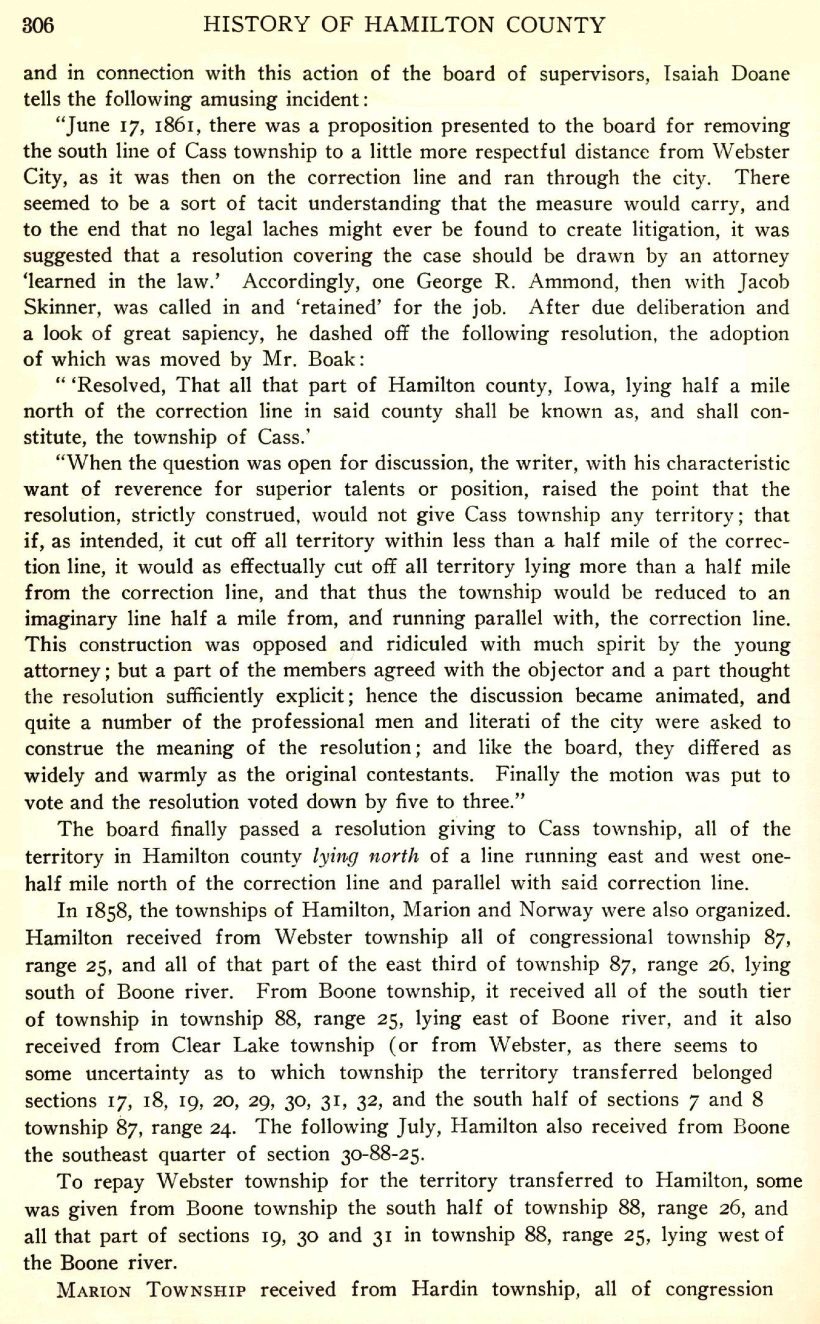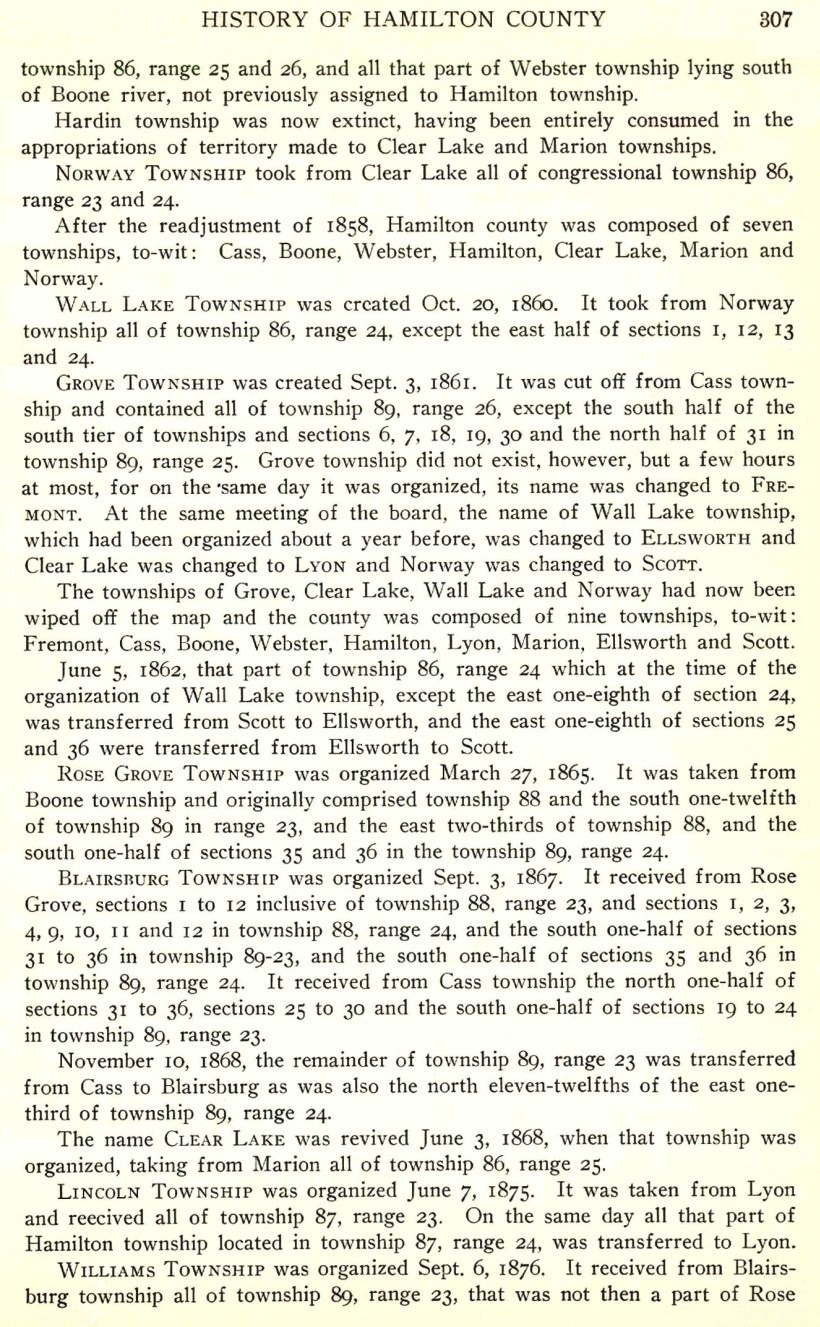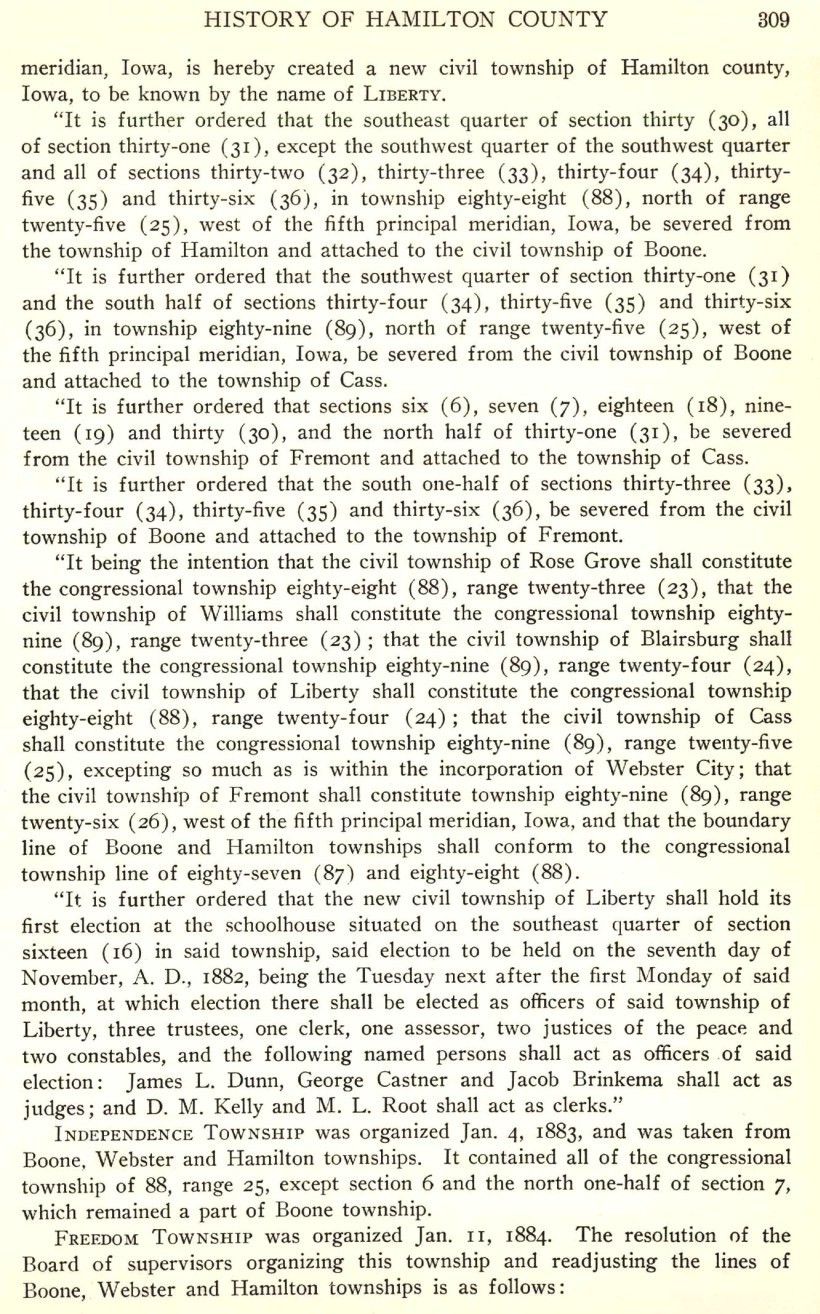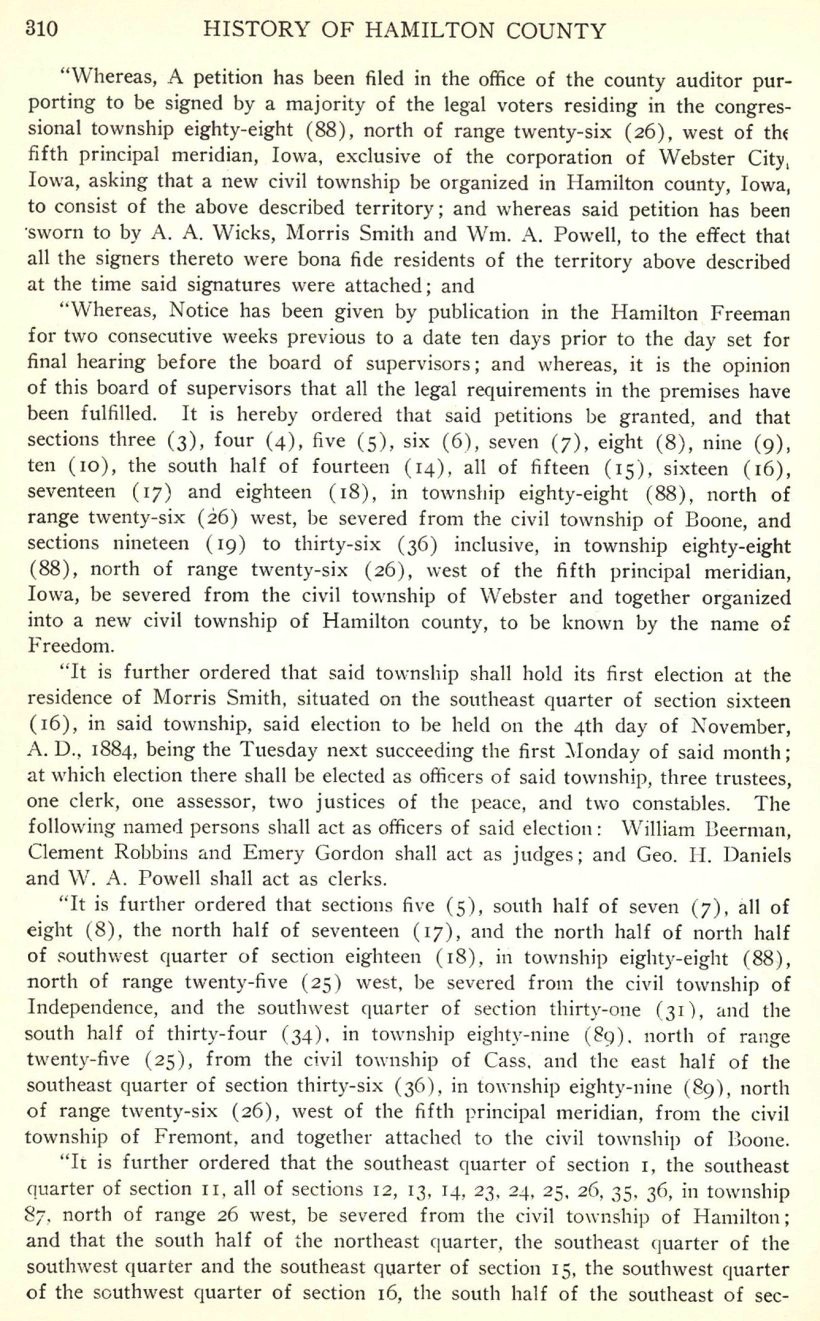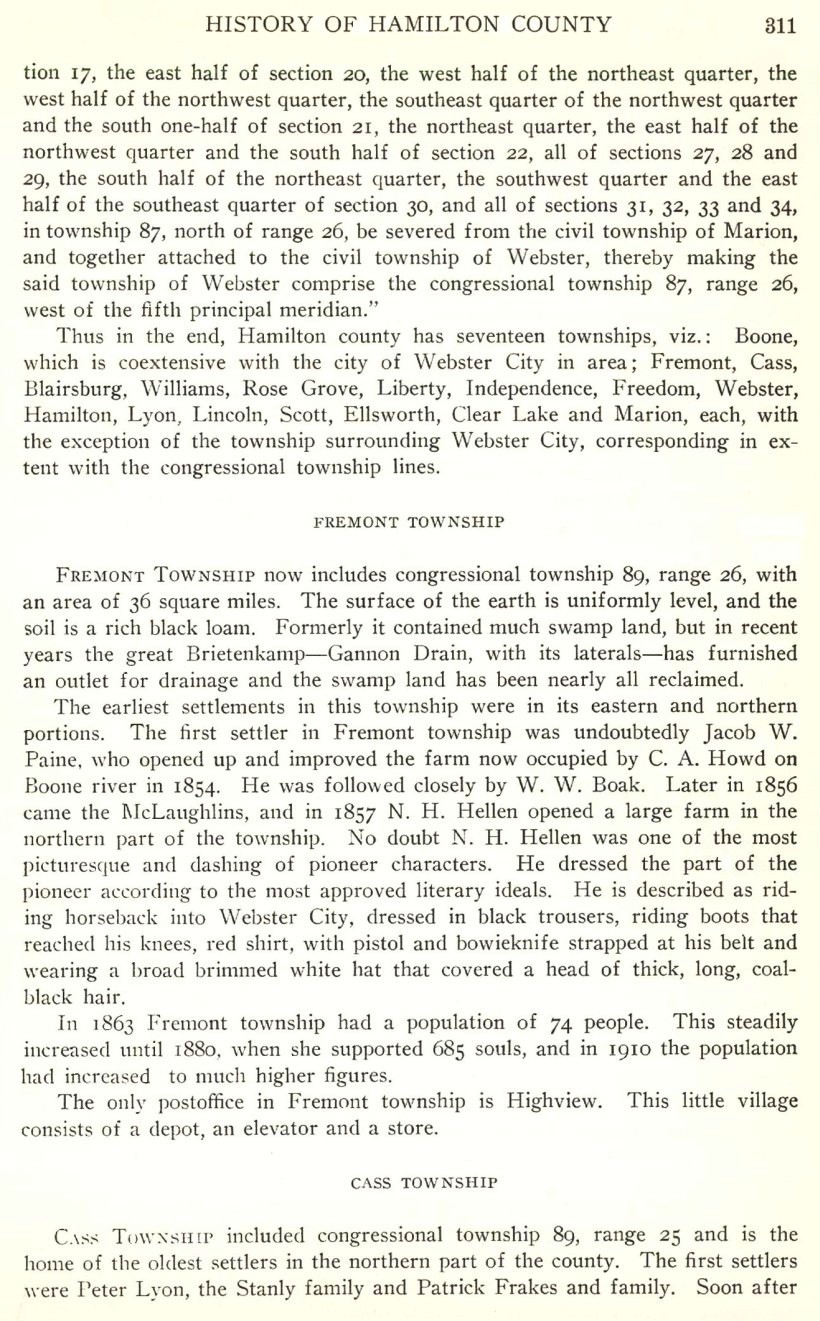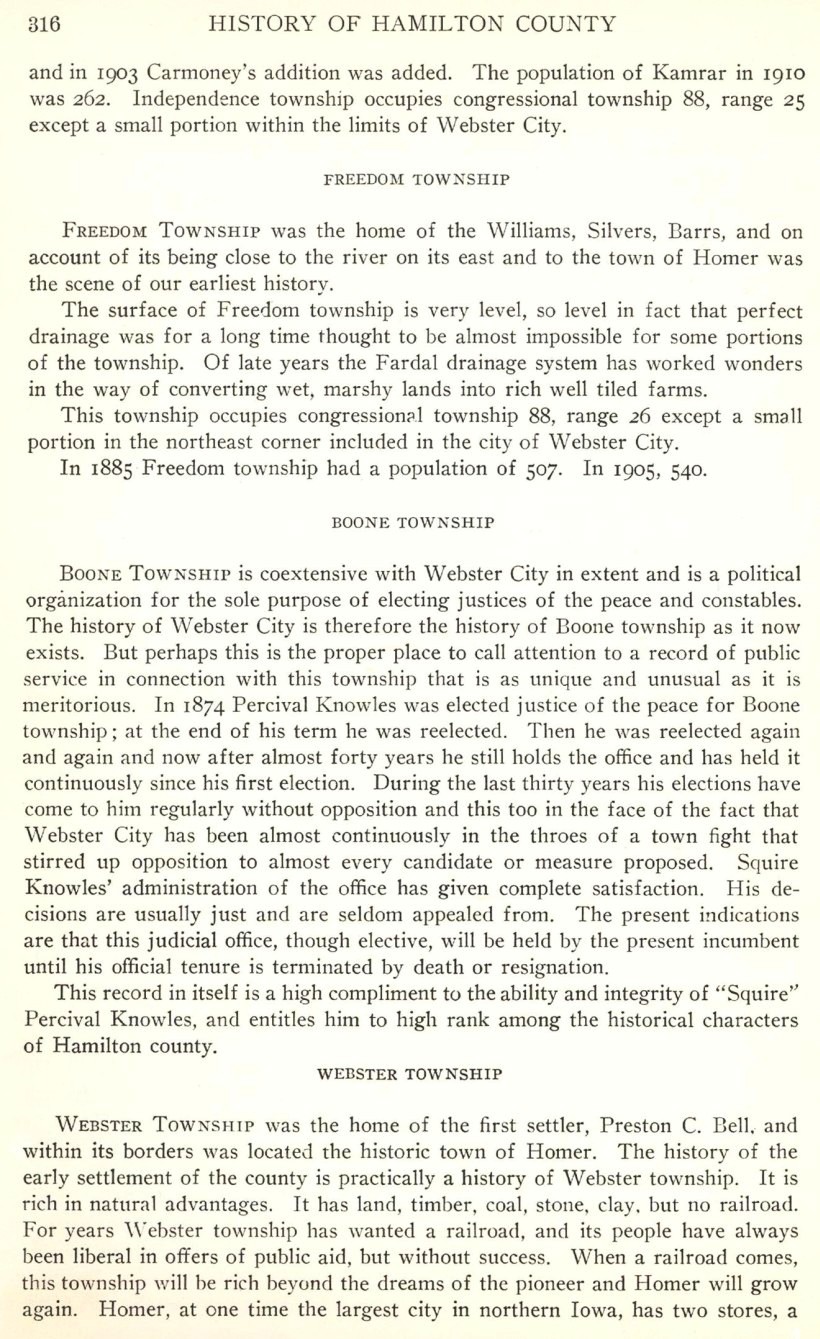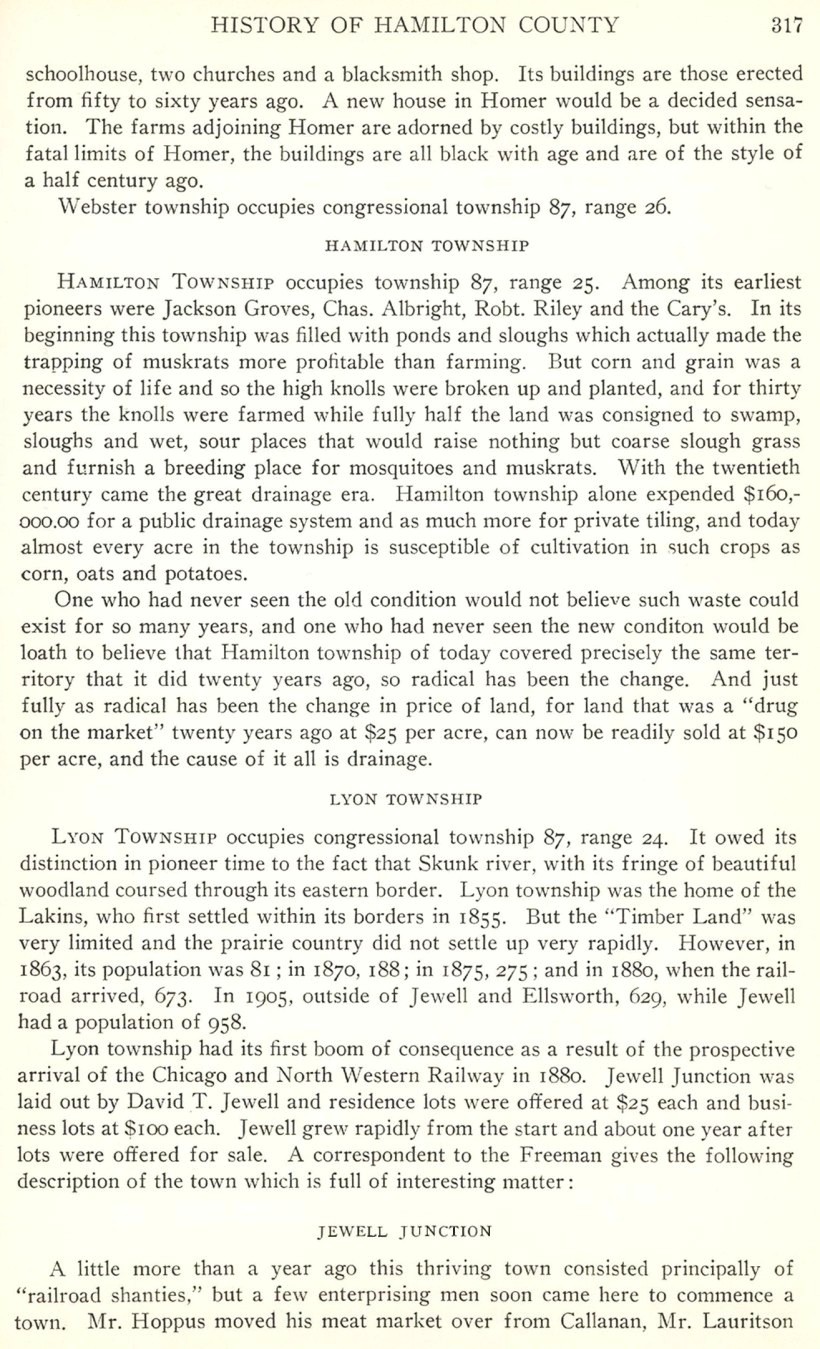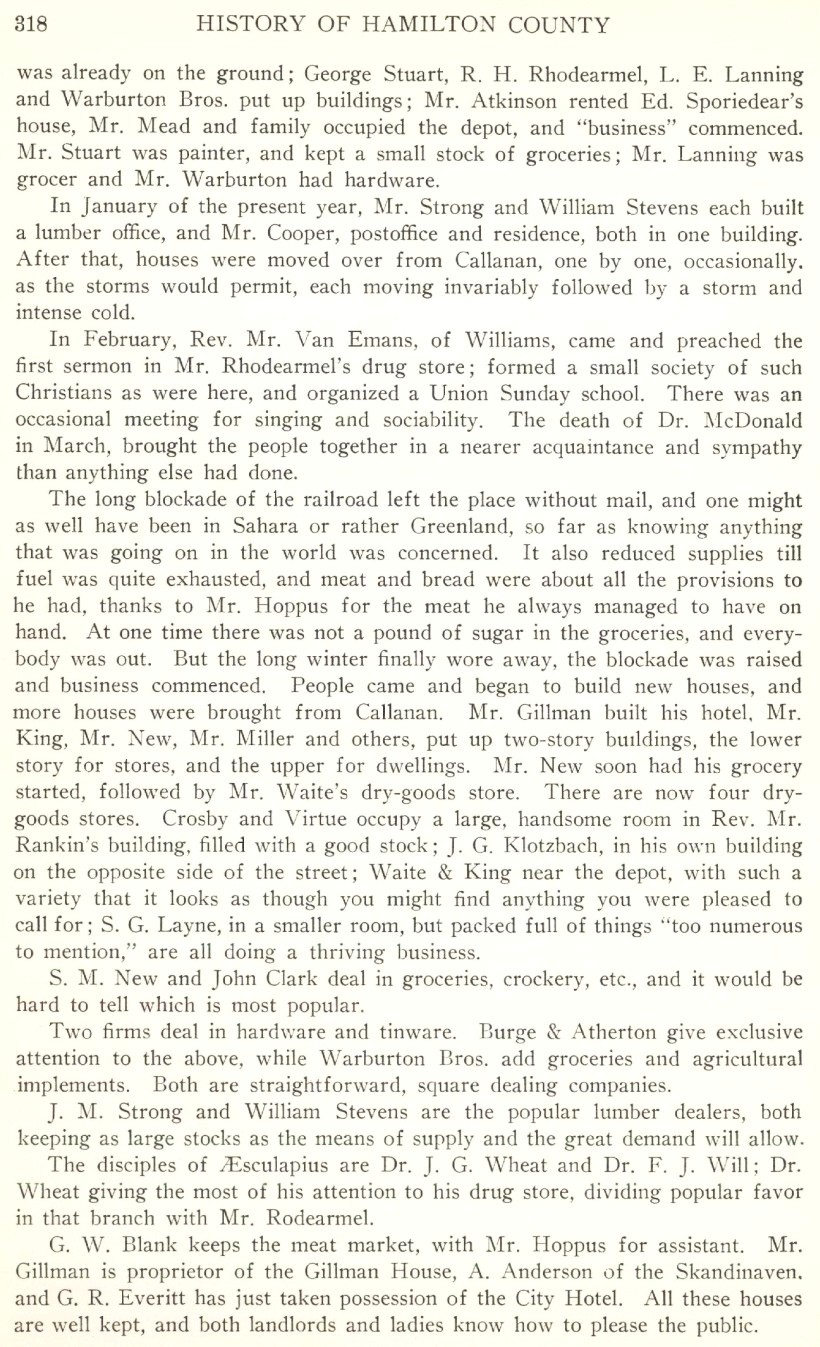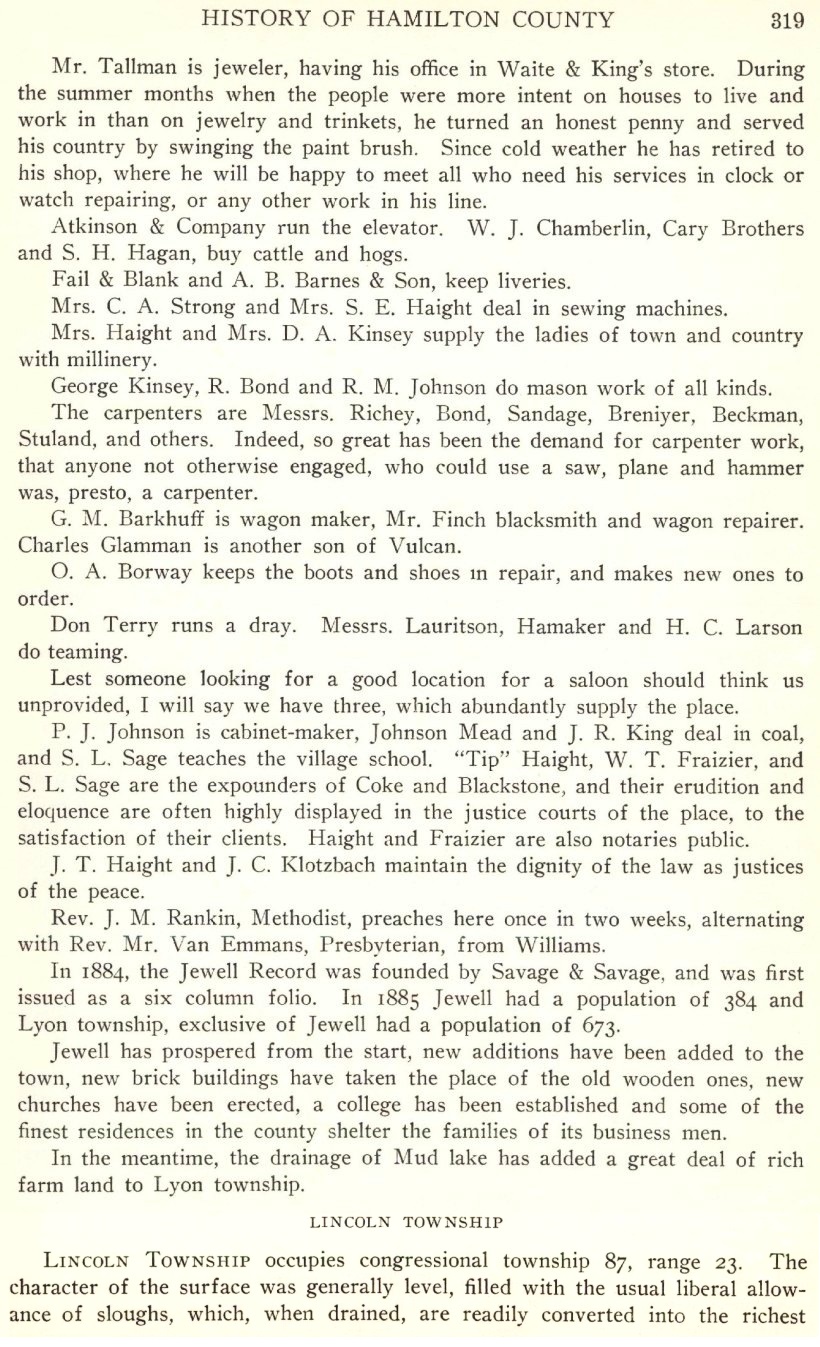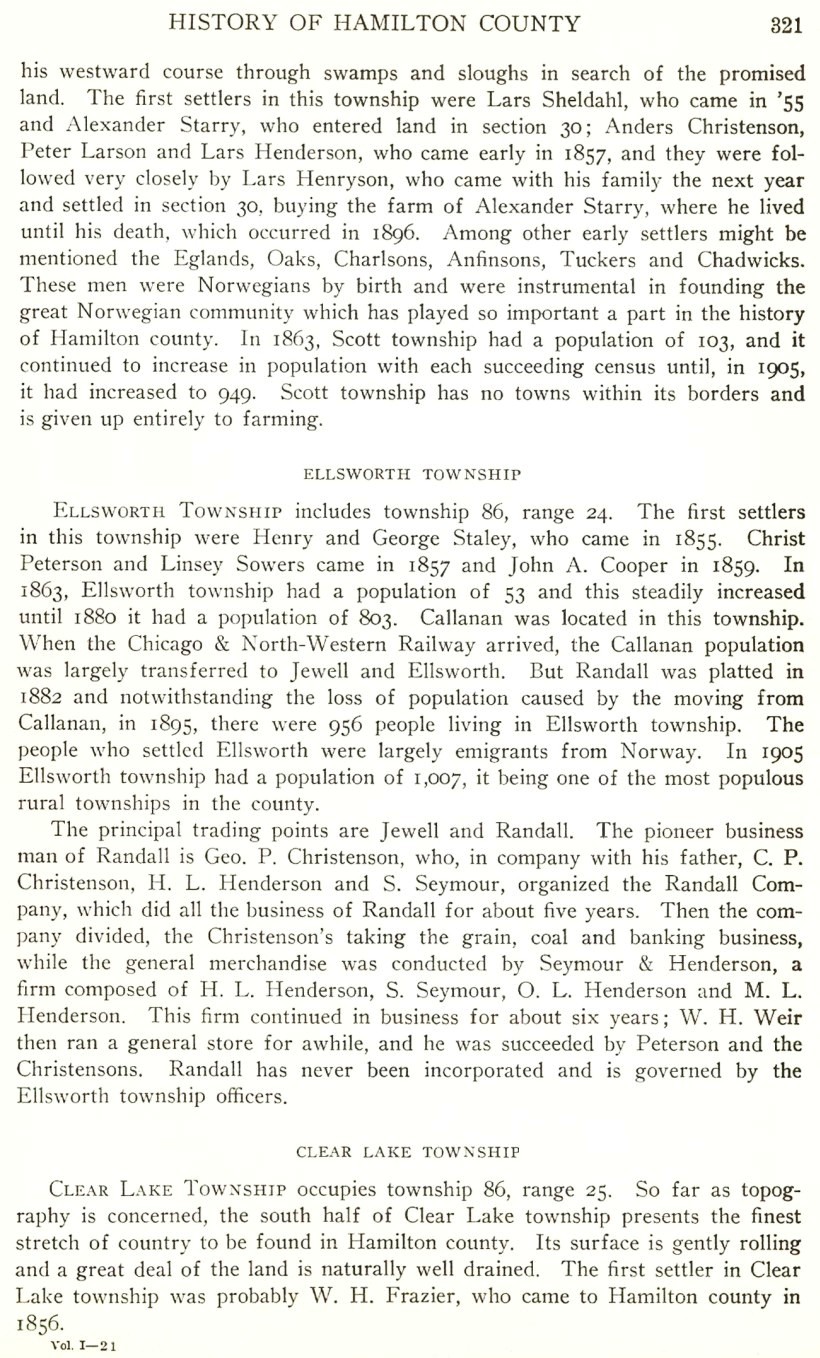AGRICULTURAL DEVELOPMENT
Not withstanding the fact that agriculture
is the oldest of known sciences and has been the main occupation of the
people of Hamilton county for over sixty years, it is still, so far as
this county is concerned, in its infancy. Until within the
last few years, farming has been looked upon as an occupation that required
nothing but strength and endurance to perform hard and unceasing manual
labor. The man who had these could succeed at farming or perhaps
it would be more appropriate to say that he could if he were so disposed
accumulate enough to enable him to move to town at the age of forty-five,
broken in health and doomed to spend the rest of his days in idleness.
The fact that farming was a scientific pursuit that required not only a
scientific education, but also a most thorough and complete business education
apparently did not occur to many who had made farming the business of their
lives. So farming in many cases has been a life of aimless
drudgery. The children have been kept out of school to work
in the fields until they were old enough to break from parental control
and flock to the towns and cities, the boys to seek enervating positions
in stores and offices, while the girls found employment in the kitchens
of their inferiors.
But happily these conditions
have now passed. The farmer of today is a student, whose term of
study never ends, an investigator, who ever sees before him, subjects for
research and experiment, new, and increasing in number. He
may not be a college graduate, but he has the education just the same,
and it is no less effective because it was self acquired, and you may depend
upon it, his sons and daughters are attending college.
In 1860 there were 139 farms
in Hamilton county and of these, only 19 were of more than 100 acres in
extent and more than half the entire number were of less than 50 acres
in extent. The farms were small, located along the streams
where timber furnished shelter and fuel, while the adjoining prairie furnished
abundance of free range for stock.
In 1870 the number of farms
had increased to 708 and still only 78 of these were over 100 acres in
extent. There were two farms of over 500 acres each.
In 1880 there were 1,565 farms nearly half of which were over 100 acres
in extent. The farms were now divided mostly into eighties,
quarters and half sections and from this time on farms of a quarter section
in size predominated. In 1875 there were 64.000 acres of improved
farm lands in Hamilton county. In 1880, 120,309; in 1885, 190.925;
in 1890, 232,315; in 1895, 240,657; in 1900, 328,308; in 1905. 326.522.
The wet years following 1900 had evidently caused some of the improved
land to "go back" as it will be noticed that the number of acres had decreased
in 1905. While there had up to the beginning of the twentieth
century been steady development in the opening up and improving of new
lands, little improvement had been made in the productive qualities of
the land that was being farmed. For in 1865 the average production
of corn was 39 bushels per acre; in 1867, 23 bushels; in 1875, 32 bushels;
in 1880, 40 bushels; and in 1905, 36 bushels, while in individual cases,
as high as 80 bushels per acre have been frequently raised, the "average"
farmer has usually been content with 40 bushels and oftentimes has been
compelled to be content with less.
The soil of Hamilton county
is so uniform in quality that the wide difference in yields so often found
on adjoining farms can only be explained by an inquiry into the methods
of farming employed.
Prior to the beginning of
the twentieth century, the development in agriculture was turned chiefly
toward the opening up of new farms and in supplying proper buildings for
the care of live stock. The land itself had been so rich that
methods to increase its productiveness were not considered and so cheap
that if the farmer needed more grain, he bought more land.
The real development in agriculture has been forced upon the people when
the demand, and consequently the price, increased until the farmer who
needed more grain could not buy the quarter adjoining him.
He began, of necessity, to look about for means for increasing the yield
on the acres he already owned. Rotation of crops, and the use
of clover was hailed as a new discovery; though in fact this "new discovery"
had been made repeatedly for centuries. But even rotation of
crops and the use of clover would not cure a condition that prevented the
full use of nearly half the land in the county. There was hardly
a prairie farm that did not have nearly half its area damaged by the presence
of sloughs and swamps. When the enterprising farmer sought
to drain his land, his neighbor in the course of drainage below him objected.
He argued. "If you turn the water from your swamp land into my land, you
will damage my farm" and the law sustained the objector. This
law was based upon a decision of the supreme court made in an early day
before the question of drainage had been seriously considered.
A man had by means of mole ditches and drains, collected all of the water
on his farm into a single channel. This channel passed across
the land of his neighbor and the volume of water flowing through the channel
was so increased by the aforesaid mole ditches and drains that it washed
out a part of the foundation from under the neighbor's corncrib.
The neighbor sued for damages and the supreme court held that the owner
of the dominant estate had no right to collect tile water on his land and
discharge upon the land of his neighbor in a way that either increased
its volume or changed the manner in which the water from above naturally
flowed to the land below.
For years this law stood directly
in the way of drainage and was a most serious stumbling block to the progress
of Iowa. Then the legislature passed a law that provided that
the owner of land might collect the water on his own land in any mannor
he saw fit, provided none of it was diverted from the natural course of
drainage and the owner of the servient estate should have no claim for
damages because the water from above came upon his land in volume or manner
different than it came naturally. This law helped a few, but
in a level country where the general fall is not more than one or two feet
to the mile, it furnished but little relief.
Then was enacted the drainage
law that has done more for Hamilton county than any law ever placed upon
the statute books of the state. As amended, it provides that
any man who owns agricultural lands that need drainage may petition the
board of supervisors for the formation of a drainage district and the board
on investigation finds that the land within the proposed district needs
drainage and the cost will not be in excess of the benefits that will accrue
to the land, it shall establish the district and construct drains which
furnish all the land in the proposed district a general outlet.
The cost of this improvement is then assessed, or apportioned among the
different forty acre tracts within the district in proportion to the benefits
received by each tract from the improvement. Under this law,
the board of supervisors of Hamilton county has established over one hundred
drainage districts, and there has been expended for public drainage improvement,
over $1,139,000. and a million more has lieen expended for private drainage
made possible by the public drainage. As a direct result of
this expenditure of a little over two millions for drainage, the lands
of Hamilton county have advanced in value over eighteen million dollars
and besides this, the increased production due to the draining out and
farming of hitherto worthless swamps, has paid for the cost of the improvements
many times over.
Yet, this great project was
met throughout with the bitterest opposition. The members of
the board who established the districts were vilified and abused in a most
shameful manner and the commissioners who spread the assessments, came
in for their share of the venom that was thoughtlessly thrown at them.
But they all persisted in the course they believed to be right, and which
proved to be the most beneficent stroke of public policy ever adopted since
the founding of the county.
Let history record on its
roll of honor, the names of George S. Neel, John H. Sparboe. H. A. Stafford,
William D. Bonner, Hampton Wilson, N. H. Bawden, men who served on the
board of supervisors of Hamilton county during the great drainage era.
Now that the possibility for
thorough drainage is secure, the farmer may well turn with hope and confidence
to the methods of agriculture that will increase his yield.
Without drainage, these methods were practicallv useless; with thorough
drainage, the wonders that can and will lie accomplished with Hamilton
county soil have never yet been realized.
Only a few years hence, when
you meet a farmer, vou will find a scientist. who knows his soil and its
needs, who knows why his crops grow or why they fail, and how that failure
may be averted. You will find him to be a business man, versed
not only in books of account, but also in methods of management that leave
no room for waste, either of product or energy. You will find
him a machinist who builds, repairs and operates the most intricate of
farm machinery and moreover, you will find him to be a gentleman who demands
and receives his just due, but is too proud to take advantage of the frailties
or ignorance of his fellow men. In all well established countries
since time began, the land owners have been the aristocrats.
Hamilton county is no exception to the rule. But the aristocracy
of Hamilton county will not be alone one of wealth but also one of education
and refinement.
|
